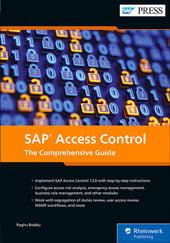The Business Role Management component of SAP Access Control allows an enterprise to control access to sensitive transaction codes and address segregation of duties (SoD) within roles before they are created/generated and assigned to users.
Through centralized role design, testing, and maintenance, Business Role Management addresses many issues with regards to role management. Besides automating role definition and management, the solution also acts as a reporting and analysis tool, thus allowing administrators to track usage and track role changes easily.
In this post, we’ll explore the benefits of using Business Role Management, including its advantages and business benefits, as well as some relevant terminology.
Why Use a Business Role Management Solution?
Keeping roles free of SoD risks and with the right authorizations across multiple systems and applications in your organization is the primary reason for adopting Business Role Management. This solution allows you to ensure that authorizations are maintained in a controlled and secure manner.
Moreover, Business Role Management ensures consistency across role development, testing, approval, and generation, which reduces ongoing maintenance. Roles can be created and managed automatically using Business Role Management. Additionally, it can identify the risks associated with roles and suggest remediation and mitigation measures at an early stage, even before roles are created.
Advantages and Business Benefits
The Business Role Management module of SAP Access Control is a comprehensive, automated solution that can enhance compliance, risk management, efficiency, and productivity while reducing costs.
Some advantages of Business Role Management include the following:
- With Business Role Management, users can identify roles more easily during the access request process by using consistent role naming conventions.
- When roles need to be maintained, Business Role Management can easily keep track of their statuses.
- By centralizing role management, Business Role Management improves efficiency by reducing manual work. Roles required across your landscape can be centralized.
- Change documents can be tracked from both the Business Role Management repository and from Transaction PFCG.
- An integral part of the role management process is the analysis and mitigation of risks.
- The Access Risk Analysis ruleset can be used to identify SoD conflicts and critical risks, so Business Role Management does not require any additional updates.
- In addition, role properties and definitions can be easily maintained.
- An automated process can be used for role recertification.
The Business Role Management module offers several business benefits, including the following.
Improved Compliance and Governance
Business Role Management helps in identifying and managing risks before role creation/modification to comply with major requirements like SoD. Your organization can ensure that only roles that are free from SoD risks are moved to production systems. A proper mitigation plan can be made well in advance if certain risks cannot be remediated.
Improved Efficiency
Through Business Role Management, your organization can improve efficiency by streamlining its role management process. Automating the creation, maintenance, and generation of roles reduces manual efforts and increases efficiency.
Better Auditing
With Business Role Management, you can identify and track changes made to roles, approvals, risks identified and mitigated, and recertifications. During compliance audits and investigations, the solution provides a 360-degree holistic view of the entire role lifecycle.
Improved Reporting
Business Role Management provides a variety of reports, including the Role Change report, the Role Owners report, the Risk Analysis report, the User Provisioning report, and so on. You can also create custom reports tailored to specific requirements, which can help track activities, identify potential risks, and comply with regulatory requirements.
Overall, Business Role Management in SAP Access Control can improve your security posture, can ensure authorization design aligns with business and compliance needs, and can enhance overall governance.
Terminology
An essential task is to understand the various terms used in Business Role Management before using it. This table lists some common terms used in Business Role Management.

Editor’s note: This post has been adapted from a section of the book SAP Access Control: The Comprehensive Guide by Raghu Boddu.



Comments